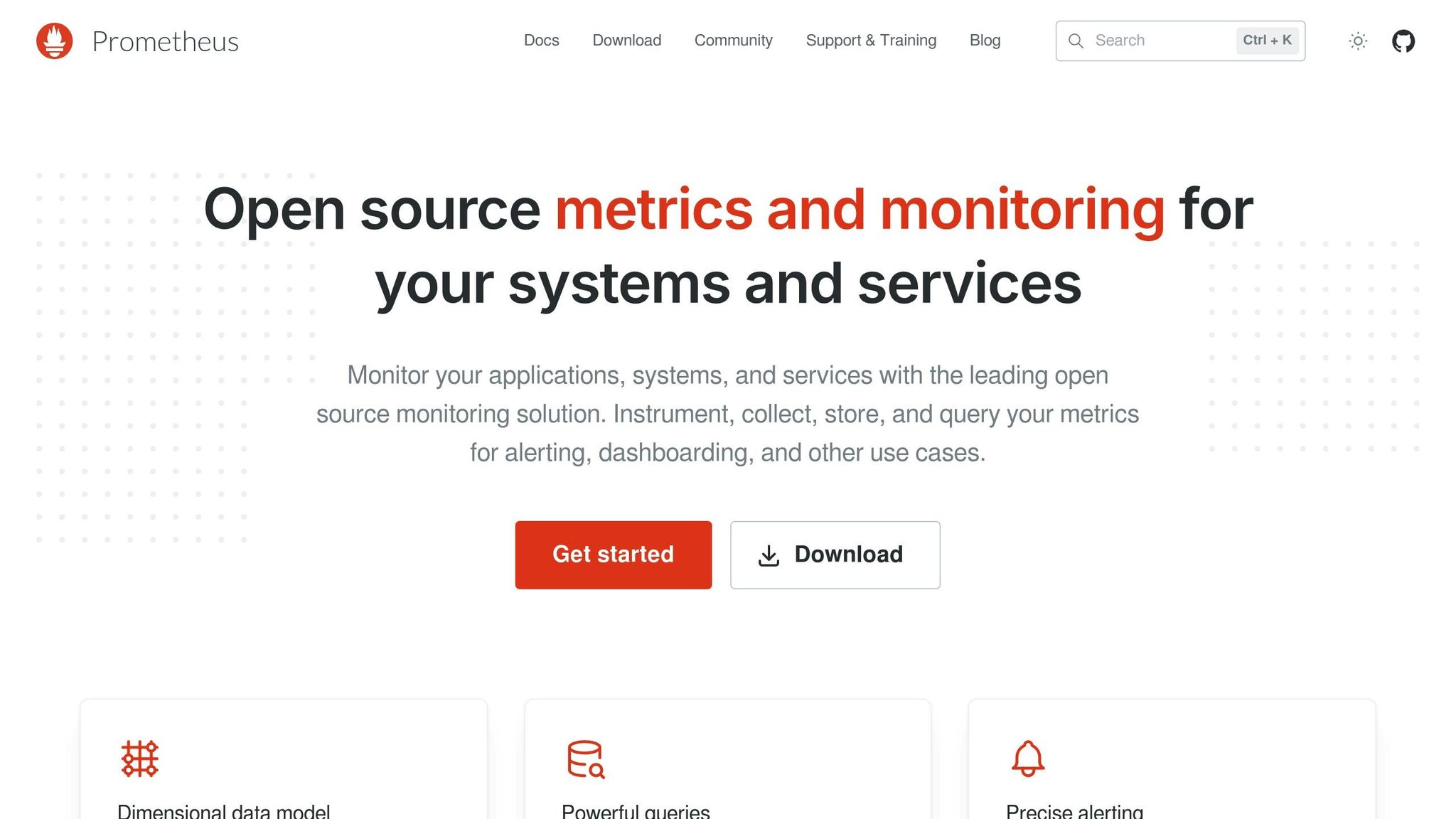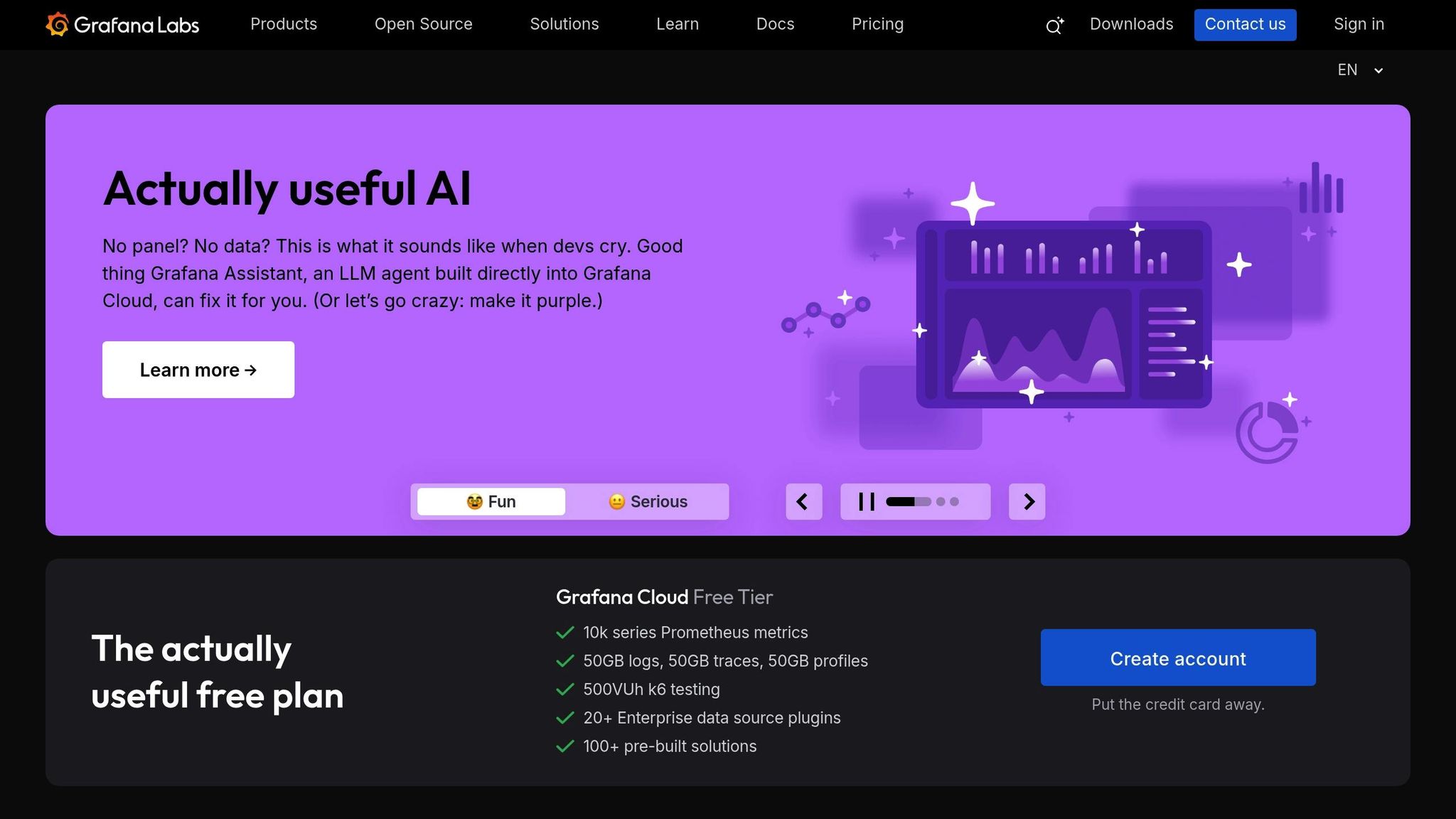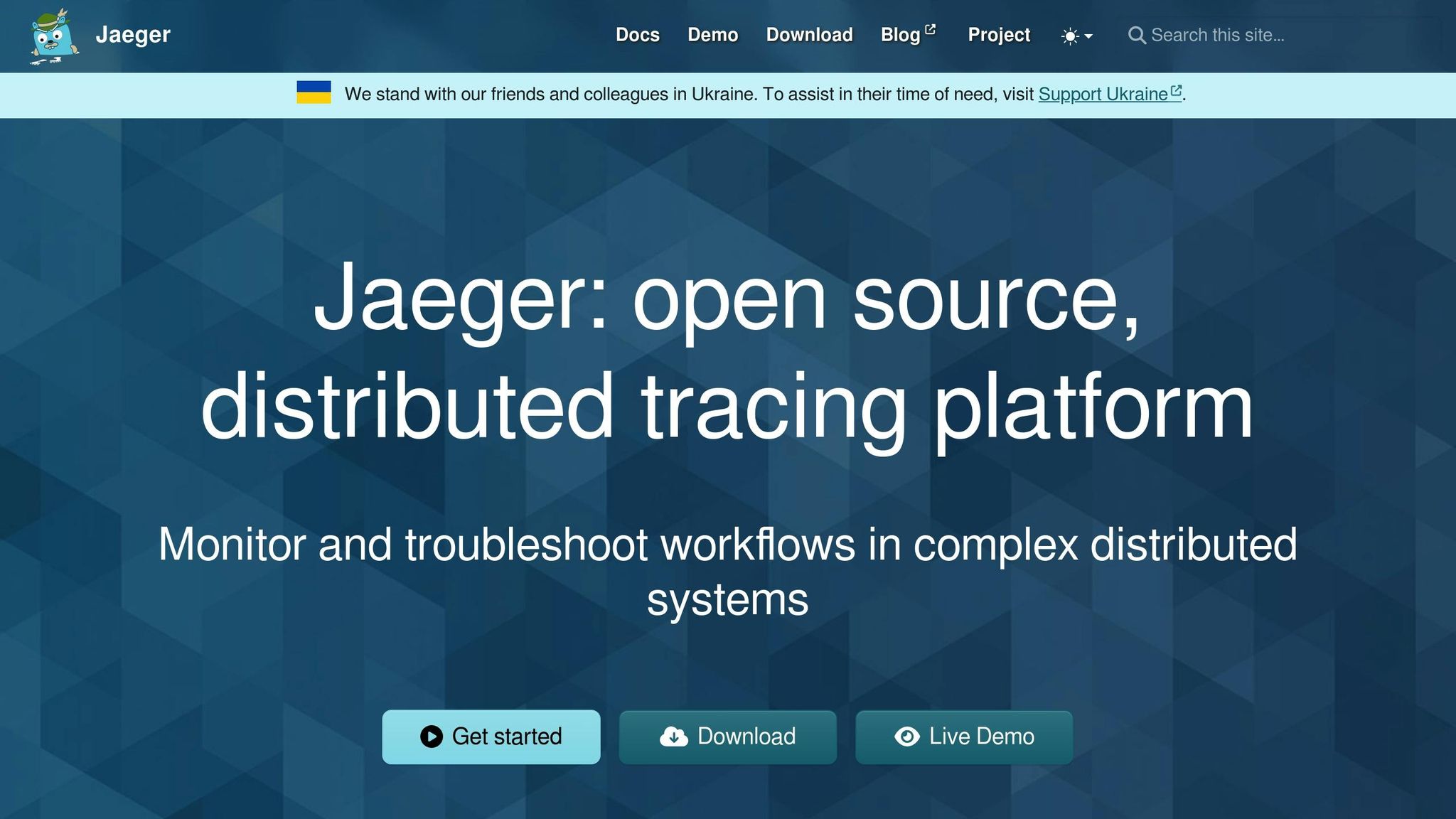Want to ensure your GitOps pipelines are reliable and efficient? Observability is key. By using tools like Prometheus, Grafana, and OpenTelemetry, you can monitor system performance, detect issues early, and reduce downtime. Here's what you need to know:
- Observability in GitOps helps confirm that your live system matches the desired state defined in Git, identifying deviations (drift) and triggering fixes automatically.
- Core tools include:
- Prometheus: Collects metrics to monitor health and performance.
- Grafana: Visualises metrics through dashboards.
- ELK/EFK: Centralises logs for detailed analysis.
- Jaeger/OpenTelemetry: Tracks request flows to pinpoint bottlenecks.
- Key practices:
- Store all observability configurations in Git for version control.
- Use Role-Based Access Control (RBAC) for security.
- Set up alerts for drift detection and system health issues.
- Regularly review metrics and logs to improve deployments and reduce costs.
Results: Faster deployments, fewer errors, and up to 50% savings on infrastructure costs. Observability transforms GitOps pipelines into systems that are reliable, efficient, and easier to manage.
How to set up Monitoring for ArgoCD
Prerequisites for Adding Observability to GitOps
Before you start integrating observability into your GitOps pipelines, it's important to lay down a secure and scalable foundation. This ensures that your implementation aligns with GitOps principles while avoiding potential rework or security issues in the future.
Required Tools and Setup
To get started, you'll need tools that can handle both Infrastructure as Code (IaC) and application deployments. Keep IaC definitions in separate Git repositories to maintain a clear distinction between application code and infrastructure or observability configurations [3][4][9].
GitOps controllers like Argo CD or Flux are essential for managing changes and continuously monitoring for configuration drift [4][8]. These tools not only apply changes but also compare your production environment with the desired state defined in Git, ensuring everything stays in sync [4][8].
For observability, you'll need a stack of complementary tools:
- Prometheus: Handles metrics collection, gathering real-time performance data from your applications and infrastructure [3][4].
- Grafana: Works with Prometheus to visualise metrics through custom dashboards, giving you a clear view of system performance [4].
- Log aggregation tools: Choose between the ELK stack (Elasticsearch, Logstash, Kibana) or its Kubernetes-native counterpart, EFK (Elasticsearch, Fluent Bit, Kibana), to centralise logs from all components [3].
- Distributed tracing tools: Tools like Jaeger or OpenTelemetry help you trace requests across microservices, making it easier to pinpoint bottlenecks or failures [3].
Before deploying these components, ensure all tools are secured to protect your system.
Security and Access Management
Security is the backbone of a reliable observability setup. Start by implementing Role-Based Access Control (RBAC) to restrict who can modify Git repositories or cluster configurations [4]. Opt for GitOps tools with strong RBAC features and seamless integration with Identity and Access Management (IAM) systems [7].
Sensitive data, such as secrets, should never be stored in plain text. Use tools like Sealed Secrets or HashiCorp Vault to encrypt and securely manage these secrets [4]. This ensures only authorised components can access critical configuration data.
Audit logging is another must-have for tracking changes and meeting compliance requirements [4]. For cloud environments, look for GitOps tools that integrate with services like AWS IAM, Amazon ECR, and CloudWatch, allowing you to enforce consistent security policies across your infrastructure [7].
Finally, configure network policies to control communication between observability components while maintaining strict security boundaries. This includes setting up firewall rules and service mesh policies if you're using tools like Istio or Linkerd.
Once security is in place, check that your infrastructure is ready to handle observability demands.
Infrastructure Readiness
Your Kubernetes cluster must have sufficient resources to support observability tools. For example, Prometheus typically requires 1–2 GB of storage per day for small to medium-sized clusters [3].
Persistent storage is critical for time-series databases like Prometheus and for log storage systems like Elasticsearch. Observability data often needs long-term retention - common practices include keeping high-resolution metrics for 15 days and aggregated data for up to 90 days. For log storage with ELK/EFK, plan capacity based on your application's logging volume [3].
Ensure your CI/CD pipeline is fully operational, with GitOps controllers like Argo CD or Flux deployed and functioning reliably [3]. Your repository should include versioned declarative configurations for all observability components, such as Prometheus scrape configurations, Grafana dashboards, and alerting rules [6]. Use namespaces to isolate observability tools from application workloads, and adopt semantic versioning (e.g., prometheus-rules-v2.1.0) for easier management and rollback [8].
Before rolling out observability at scale, create a proof of concept to test how well it integrates with your existing tools and workflows [7]. Configure automated rollbacks in your GitOps tool to revert deployments to the last stable state in case of failure. This reduces manual intervention and shortens recovery times [4]. Lastly, set up alerting rules to notify you when configuration drift occurs, enabling quick remediation when the actual state deviates from the desired state in Git [8].
Step-by-Step Guide to Adding Observability Tools
With your infrastructure ready, it’s time to implement observability tools. Each tool has a specific role, and together they give you a clear view of how your GitOps pipeline is performing and whether it’s healthy.
Setting Up Metrics with Prometheus

Start by deploying Prometheus using Helm or Kubernetes manifests stored in Git to stay aligned with GitOps principles. Configure Prometheus to collect metrics from various cluster components - like nodes, pods, and services - using ServiceMonitors and PodMonitors. These resources define which endpoints to monitor and how often data should be gathered.
For GitOps controllers like Argo CD or Flux, set up specific scrape targets to monitor metrics such as synchronisation statuses, deployment success rates, and reconciliation times. Adjust the scrape intervals carefully to balance real-time insights with system performance.
Define alerting rules directly within your Prometheus configuration files. Focus on critical issues like failed synchronisations, resource shortages, or mismatches between the live cluster state and the desired state defined in Git. Save these alerting rules as YAML files in your Git repository, ensuring they’re version-controlled for easy tracking and rollback.
Make sure Prometheus retains metrics for a duration that fits your troubleshooting and capacity planning needs. Use persistent volumes to ensure data continuity during pod restarts. Once metrics are collected, you can visualise them using Grafana dashboards.
Creating Dashboards with Grafana

Using the metrics gathered by Prometheus, deploy Grafana in your Kubernetes environment and configure it to use Prometheus as a data source. Then, create dashboards to track deployment health, synchronisation status, and overall cluster performance in real time.
Your dashboards should include panels for key metrics, such as deployment success rates (both successful and failed deployments) and GitOps reconciliation times. For example, longer reconciliation times could signal resource constraints or configuration issues. Add panels to monitor pod health across namespaces, which can help you quickly identify application problems.
Customise dashboards for specific environments - like development, staging, and production - so each reflects its unique performance metrics and thresholds. Use UK date and time formats (DD/MM/YYYY, 24-hour) for consistency.
Export your Grafana dashboards as JSON files and store them in Git to maintain version control. This way, any changes can go through proper review and be rolled back if needed. Set up automated alerts in Grafana for critical thresholds, such as high deployment failure rates or nearing resource limits. Notifications can be sent via email or messaging platforms.
With metrics and dashboards in place, the next step is to centralise your logs using the ELK or EFK stack.
Collecting Logs with ELK/EFK
Centralised logging gives you detailed insights into deployment events and how applications are running. Depending on your Kubernetes setup, choose between the ELK stack (Elasticsearch, Logstash, Kibana) or the EFK stack (Elasticsearch, Fluent Bit, Kibana). The latter is often a better fit for cloud-native environments.
Deploy Elasticsearch with enough persistent storage to handle your log data. Use Fluent Bit or Logstash for collecting logs, and organise them by environment, application, and log level using distinct index patterns.
Configure your log collectors to parse structured logs and enrich them with metadata - such as namespace, pod name, and deployment version - so you can quickly pinpoint issues during investigations.
In Kibana, create dashboards to track deployment events, error rates, and audit trails. For example, you can correlate spikes in errors with recent deployments to identify problem areas. Filters can also help isolate logs from specific deployments or time periods.
Set log retention policies that align with UK data protection standards while managing storage costs. For instance, you might retain detailed logs for 30 days and summary data for longer periods. Automating index lifecycle management can make log rotation easier. Once your logs are centralised, you can expand observability by incorporating tracing with Jaeger or OpenTelemetry.
Adding Tracing with Jaeger or OpenTelemetry

Distributed tracing helps you identify performance bottlenecks across microservices in your deployment pipeline. OpenTelemetry is a popular choice due to its vendor-neutral approach and extensive instrumentation libraries.
Deploy the OpenTelemetry Collector in your Kubernetes cluster to handle trace data. Configure it to send this data to Jaeger for storage and analysis, and track these configurations in your Git repository.
To capture trace data, integrate OpenTelemetry libraries into your application code. Focus on critical operations like database queries, external API calls, and internal service communications. You can also instrument GitOps controllers to trace synchronisation processes, giving you insights into each deployment step.
Use Jaeger’s interface to analyse trace data and spot patterns or bottlenecks. Look for operations that consistently take longer than expected or show high error rates. Set up alerts based on trace data, such as when response times exceed acceptable thresholds or error rates spike. Combine these insights with your metrics and logs for a complete view of system behaviour, ensuring your live environment matches the desired state defined in Git.
Need help optimizing your cloud costs?
Get expert advice on how to reduce your cloud expenses without sacrificing performance.
Best Practices for Observability in GitOps
Once your tools are in place, it's essential to follow some key practices to maintain a reliable and versioned observability setup within your GitOps pipeline.
Version Control for Observability Configurations
Keep all your observability assets - such as Grafana dashboards, Prometheus alert rules, and OpenTelemetry configurations - stored in Git. This ensures every change is auditable and reversible. Use structured directories and meaningful commit messages to keep things organised and transparent.
For example, you can store Prometheus alert rules in a /monitoring/alerts directory and Grafana dashboards in /monitoring/dashboards. Any updates to these configurations should go through branches and pull requests, allowing for peer review and creating a clear audit trail. This approach is particularly helpful for compliance needs. If a new alert rule generates too many notifications or a dashboard update reduces clarity, you can revert to the last working version stored in Git[5][6][8].
Tag your releases with version numbers that align with your application deployments. This makes it easier to trace specific application versions back to their corresponding monitoring setups, which simplifies troubleshooting when issues arise.
Finally, ensure that deviations from these versioned configurations are quickly identified and resolved.
Automated Drift Detection and Alerts
Configuration drift - when your live environment differs from what's defined in Git - can undermine the GitOps model. To address this, set up GitOps controllers to monitor observability configurations and detect unauthorised changes. Use Prometheus alert rules to flag synchronisation failures or discrepancies between the live and desired states[2][4].
Tools like Argo CD and Flux can monitor not only application configurations but also observability setups. If someone manually alters a Grafana dashboard or adjusts Prometheus scrape configurations outside of Git, these controllers can trigger alerts through Slack, email, or other notification channels.
Prometheus alerting rules can also help monitor the health of your GitOps synchronisation process. For instance, you could set up an alert to notify you if Argo CD hasn't successfully synchronised within the last 10 minutes. This kind of alert can highlight potential configuration errors or connectivity issues.
Additionally, track the performance and availability of your observability tools using custom metrics. Ensure Prometheus is scraping all targets, Grafana dashboards are loading correctly, and log collection is functioning as it should. These metrics allow you to spot potential problems before they escalate into system-wide monitoring failures.
Auditing and Compliance Monitoring
Auditing plays a crucial role in ensuring your observability practices meet security and operational standards. This is particularly important for organisations in the UK that need to comply with regulations such as ISO/IEC 27001 or FCA requirements for financial services[4].
Enable audit logging and implement RBAC (Role-Based Access Control) for Git repositories managing observability configurations. Regular compliance reviews and automated scans can help ensure adherence to required standards. Reports should use UK formats for dates (DD/MM/YYYY) and present any cost-related information in pounds sterling (£).
Schedule periodic compliance reviews to check that monitoring data is being collected according to retention policies, verify that access controls are functioning correctly, and confirm that audit logs are being preserved for the required duration. Automated compliance scanning tools can also identify security vulnerabilities or misconfigurations in your observability stack before they are deployed, reducing manual effort and maintaining high standards.
Document changes clearly by creating deployment history reports. These reports should link application updates to corresponding monitoring configuration changes, providing traceability. Such records are invaluable during incident investigations and demonstrate due diligence to auditors.
Using Observability for Continuous Improvement
Observability takes monitoring to the next level, transforming it into a tool for ongoing optimisation. By analysing metrics, logs, and traces, you can gain actionable insights that improve deployment speed, reduce infrastructure costs, and enhance operational decision-making.
Improving Deployment Cycles
Tracking deployment metrics such as frequency, build duration, failure rates, and recovery times allows you to identify and address bottlenecks in your pipeline.
For instance, end-to-end deployment traces - from code commit to production - can help pinpoint delays. Distributed tracing might reveal whether slow-running tests, resource conflicts, or manual approvals are holding things up. One example saw a client cut deployment time from 6 hours to just 20 minutes by leveraging detailed monitoring data [1].
Resource utilisation is another area to monitor closely. Analysing CPU and memory consumption during builds and deployments can highlight inefficiencies. For example, if your build agents are using far less capacity than allocated, you could reduce instance sizes to save costs or increase parallel jobs to speed things up.
Grafana dashboards are invaluable for visualising deployment performance. By tracking metrics like average deployment times, success rates across environments, and rollback frequency, you can identify trends and measure the impact of improvements. These insights not only help accelerate deployments but can also reveal opportunities to trim excess spending.
Reducing Cloud Costs
Observability plays a key role in identifying and eliminating unnecessary cloud expenses. By analysing resource consumption patterns, you can uncover areas ripe for cost savings.
Tools like Prometheus and Grafana provide visibility into CPU, memory, storage, and network usage. For example, virtual machines with consistently low CPU usage could be downsized or consolidated. Similarly, Kubernetes data can highlight over-provisioned workloads. If a pod requests 2 GB of memory but only uses 500 MB, you're effectively wasting resources and money.
Hokstad Consulting has demonstrated how observability data can lead to major savings. Their approach involves collecting comprehensive metrics and analysing usage patterns to suggest optimisations, such as implementing auto-scaling, purchasing reserved instances, or consolidating workloads.
Storage costs often present another opportunity for savings. Monitoring growth rates, access patterns, and retention policies can help identify unused volumes, oversized backups, or data that could be shifted to more economical storage tiers. Setting up alerts for resource spikes or idle periods further ensures efficient cost management.
Data-Driven DevOps Decisions
The metrics, logs, and traces collected through observability can guide smarter decisions in scaling, security, and performance.
Scaling decisions, for instance, can be based on actual usage patterns. If your application sees predictable traffic increases on weekday mornings, you can scale resources proactively rather than waiting for performance issues to arise.
Security also benefits from observability. Monitoring authentication logs, access patterns, and system behaviours can help you detect threats or policy breaches early and respond quickly.
Performance optimisation is another area where observability shines. Application monitoring can uncover slow database queries, inefficient API calls, or memory leaks, while infrastructure monitoring can reveal resource constraints affecting performance. A/B testing changes with a subset of your infrastructure allows you to measure their impact before a full rollout.
Hokstad Consulting applies these principles to their DevOps projects, achieving outcomes such as 75% faster deployments and a 90% reduction in errors through evidence-based improvements [1].
Regular reviews of observability data are essential for continuous improvement. Weekly or monthly evaluations of deployment metrics, resource usage, and cost trends can help you identify patterns and opportunities for optimisation. Documenting these findings and tracking the results of implemented changes builds a knowledge base that informs future decisions.
When observability data is treated as a strategic asset, it transforms your GitOps pipeline into a self-improving system that delivers better performance, reduced costs, and greater reliability over time.
Conclusion
Bringing observability into GitOps pipelines transforms infrastructure management from reactive problem-solving to proactive fine-tuning. By leveraging metrics, logs, and traces, teams gain a clear view of whether the live system aligns with the Git-defined state. This alignment isn’t just helpful - it’s a cornerstone of effective GitOps [2]. With this level of clarity, teams can achieve measurable operational gains.
The advantages are evident. Teams often report faster workflows and fewer errors, while also cutting infrastructure expenses by an impressive 30-50% [1]. Features like automated drift detection, real-time monitoring, and data-driven decision-making streamline operations, reducing manual interventions and mistakes.
Version-controlled observability setups further enhance efficiency by ensuring auditability and enabling quick rollbacks. This supports compliance requirements and smooth operations alike [6][5].
The financial benefits are equally compelling. Tools such as Prometheus and Grafana help organisations analyse resource usage, uncovering over-provisioned workloads, idle storage, and scaling inefficiencies. For example, Hokstad Consulting has shown how clients can save over £50,000 annually by using data-driven optimisation strategies to reduce cloud costs.
Observability also fosters continuous improvement. By regularly reviewing deployment metrics, resource consumption, and performance data, organisations create a feedback loop that enhances reliability, speed, and cost management over time. When observability data is treated as a strategic resource, it transforms the GitOps pipeline into a system that continually evolves and improves.
Incorporating observability into GitOps lays the groundwork for infrastructure management that’s not only reliable and efficient but also adaptive to future demands. By aligning observability with GitOps principles, you create a scalable, cost-conscious process that grows with your organisation’s needs.
FAQs
How does integrating observability enhance the efficiency and reliability of GitOps pipelines?
Integrating observability into GitOps pipelines can make your CI/CD workflows more transparent, efficient, and dependable. By incorporating observability tools, you gain the ability to track pipeline performance, spot bottlenecks, and address issues swiftly - before they disrupt deployments.
Some standout advantages include gaining real-time visibility into system health, better error detection and resolution, and improved pipeline efficiency. These measures help teams maintain steady performance, minimise downtime, and ensure delivery cycles run more smoothly and predictably.
What tools and practices are essential for adding observability to a GitOps pipeline?
To bring observability into your GitOps pipeline, you'll need a blend of reliable tools and smart practices that allow for real-time monitoring, quick debugging, and fine-tuning of your workflows.
Start with the right tools. These include logging frameworks (like centralised log aggregation systems for tracking logs across services), metrics collection platforms (to measure performance and resource usage), and tracing tools (to follow request paths and spot bottlenecks). Make sure these tools align with your GitOps environment and can be seamlessly automated within your CI/CD pipeline.
On the practices side, focus on instrumenting your applications for observability, setting up alerts for key metrics, and maintaining dashboards that provide clear visibility into your systems. These steps will help you catch and address issues before they escalate. By weaving observability into your GitOps workflows, you'll not only streamline deployments but also build a foundation for more dependable systems.
How can integrating observability into GitOps pipelines improve efficiency and reduce costs?
Integrating observability into GitOps pipelines can transform the way deployment processes are managed. By improving visibility and control, teams can streamline operations and address issues more efficiently. With effective monitoring and automation in place, it's possible to reduce errors by up to 90% and boost deployment speeds by as much as 75%.
Beyond operational benefits, observability tools can also help cut costs. By proactively managing resources and fine-tuning infrastructure, organisations can reduce cloud expenses by 30–50%, avoiding unnecessary spending while maintaining performance.
